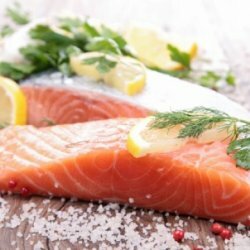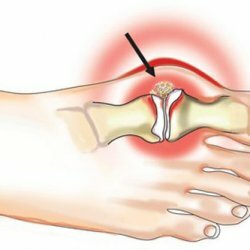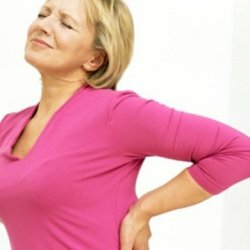Juvenile rheumatoid arthritis (JRA) in children: treatment, prognosis
Juvenile rheumatoid arthritis (JRA) is a pathology characterized by the development of an inflammatory process in the joints and their restriction in movement.
The duration of the course of the disease is 2.5 months or longer. This type of arthritis affects children under the age of 16.
Content
- ICD-10 code
- Juvenile rheumatoid arthritis causes
- Juvenile rheumatoid arthritis symptoms
- Diagnostics
- Juvenile rheumatoid arthritis treatment
- Drug treatment
- Solving the problem through surgical intervention
- Complementary and alternative treatments
- Nutrition and Supplements
- Folk remedies (traditional medicine recipes)
- Therapeutic load for joints
- Prophylaxis
- Forecast for the future
- Related Videos
ICD-10 code
ICD code 10 - M08 (juvenile [juvenile] arthritis).
Includes: arthritis in children that begins before the age of 16 and lasts more than 3 months.
Juvenile rheumatoid arthritis causes
The exact causes of the development of the disease have not yet been established. However, based on the research conducted, doctors are inclined to believe that genetics and heredity are directly related to the appearance of this disease.
ON A NOTE! Juvenile arthritis in children is 2 times more common in girls.

Factors that can provoke changes in the processes of the body, and in the future lead to a pathological state:
- contact with an infection of a viral, bacterial nature;
- drop in body temperature to critical levels (hypothermia);
- past joint injuries;
- prolonged exposure to the sun;
- untimely vaccination as a prophylaxis.
After encountering one of the environmental factors, the immune system changes so that its cells are identified as foreign. Simply put, an autoimmune reaction is formed, which is the basis of juvenile rheumatoid arthritis (JRA).
Juvenile rheumatoid arthritis symptoms




The disease in question, depending on the form, manifests itself in different ways. The general clinical picture characteristic of all types of arthritis is as follows:
- pain syndrome around the circumference of the joint, stiffness at the moment of movement (mainly in the morning);
- redness of the skin in the affected area;
- swelling in the joint area;
- feeling of warmth in the affected area;
- severe pain in movement, as well as in an immobilized state;
- limbs bend poorly, the appearance of subluxation in the joints;
- brown spots are formed near the nail plates;
- a pronounced feeling of weakness in the body;
- anemia, pallor of the epidermis.
Since arthritis in children is classified into several types (reactive, subacute, oligoarticular), then, in addition to common features, each of them is characterized by additional features. Let's consider each one separately.
Signs of reactive juvenile arthritis:
- increased body temperature;
- a kind of allergic rash;
- an increase in the size of the liver, spleen, peripheral lymph nodes;
The subacute type of childhood arthritis manifests itself as follows:
- low intensity pain;
- swelling around the joint, disruption of its performance;
- tension in movement in the morning;
- a slight increase in temperature (very rarely observed);
- slight enlargement of lymph nodes, liver and spleen in a normal state.
Oligoarticular juvenile arthritis symptoms:
- unilateral inflammatory process;
- stunted growth;
- cataract (cataract);
- asymmetrical position of the limbs of the body;
- inflammation of the inner membranes of the eyes.
Diagnostics
At the first complaints of pain in the articular area, parents should contact a pediatric rheumatologist. At the appointment, the doctor will review the child's medical history and ask adults about the diseases of close relatives (refutation / confirmation of the heredity factor).
Then the physician will carry out a visual and tactile examination, ask about the symptoms that appear, their intensity and when the first complaints arose.
After completion of admission, a list of examinations is prescribed:
- detailed blood test;
- general urine analysis;
- biochemical blood test: C-reactive protein, total protein, blood sugar, liver enzymes, creatinine.
- analysis of biomaterial in the presence of rheumatoid factor;
- provided that the child is often sick sore throat, prescribe a blood test for antistreptolysin-O, indicating streptococcus in the child's body;
- immunological blood test.
Read also:What is CMT physiotherapy (amplipulse therapy), what diseases is it used for?
In addition to laboratory examinations, they carry out:
- Ultrasound of disturbing joints;
- radiography;
- Ultrasound of the abdominal area;
- ECG and ultrasound of the heart;
- ultrasound examination of the kidneys.
Consultation of specialists in the following areas is required without fail: neurologist, ophthalmologist, ENT doctor. Having received the results of all the tests passed, confirming the presence of juvenile rheumatoid arthritis, the attending physician draws up an individual patient therapy regimen.
ATTENTION! The future prognosis for the patient depends on the effectiveness of the prescribed treatment.
Juvenile rheumatoid arthritis treatment
Juvenile arthritis is a serious and complex disease that requires complex treatment. Treatment is aimed not only at eliminating pain and inflammation in the joint area, but also at minimizing the consequences in the future from a pathological phenomenon.
In the active phase of the disease, the patient is taken to the hospital, where he is monitored by medical workers. In the inactive period, outpatient supervision is required, as well as spa treatment. In the latter case, a therapeutic scheme is drawn up for the child, the basis of which is drug treatment, physiotherapy exercises, massage sessions, physiotherapy. A positive result is possible only with the above treatment on a long-term and uninterrupted basis under the strict supervision of a leading physician. Dieting is also part of this complex.
Drug treatment

Drug therapy falls into two categories:
- medicines to relieve symptoms of the disease. This group includes non-steroidal anti-inflammatory drugs (NSAIDs), glucocorticoids.
- taking immunosuppressive drugs (immunosuppressive treatment) - suppression of unwanted reactions of the immune system.
Non-steroidal anti-inflammatory funds - medications that can eliminate pain syndrome, but are unable to completely eliminate the inflammatory reaction when rheumatoid arthritis. The most commonly used tools include:
- Ibuprofen;
- Meloxicam;
- Nise;
- Diclofenac.
ON A NOTE! They have proven themselves in the field of rheumatology Nise drug (its analogue is Nimesulide). In medical practice, it has been noticed that of the entire list of non-steroids, this agent has the mildest effect on the body of children and rarely causes side reactions.
Corticosteroids (hormonal anti-inflammatory drugs) - are used to accelerate the removal of inflammation in the articular region. The main plus is that drugs of this group are excreted from the body in a short time. The main disadvantage is the manifestation of many side effects. Commonly used glucocorticoids in juvenile arthritis are:
- Prednisolone;
- Betamethasone.
Juvenile rheumatoid arthritis in adult children with internal organ involvement can be treated with pulse therapy. With this method, intra-articular administration of hormonal drugs in a high dosage is performed.
ATTENTION! This method is forbidden to practice on children under the age of 3 years, since growth retardation is possible.
Immunosuppressive medications - drugs that suppress the activity of the body's immune sphere. With childhood juvenile arthritis, this group of drugs must be used for a long time, this is the only way to achieve the desired result. It should be noted that the frequency of reception is small. Medicines are required to be taken 3 times every 7 days. Commonly used immunosuppressants:
- Leflunomide;
- Methotrexate;
- Cyclosporine.
ATTENTION! Prescribing drugs is in accordance with the characteristics of the child's body and the development of the disease.
Methotrexate - a popular medicine in the treatment of juvenile rheumatoid arthritis. Its use gives excellent results. Most patients are well tolerated. However, at the beginning of treatment, side effects such as nausea and vomiting are possible. The dosage is selected by the attending physician in accordance with the patient's weight and height. Spontaneous cancellation is not allowed. When the specialist decides to finish the appointment, usually it happens after 2 years of remission.
Read also:Autoimmune diseases: a list of diseases

IMPORTANT! It often happens that during the period of drug treatment Methotrexate the patient is in remission, clinical manifestations disappear, and the child's parents decide to stop taking the medication without the permission of the leading physician. As a result, juvenile arthritis goes into an exacerbation phase.
Relatively recently, drugs called biological agents. They are proteins that bind to immune cells, which further suppress their activity. Such therapy significantly improves the patient's condition, eliminates pain and stiffness, and increases the period of remission. List of drugs:
- Remicade;
- Humira;
- Rituximab.
Solving the problem through surgical intervention
The surgical method in the treatment of juvenile arthritis is rarely used. This method is indicated in cases where the deformation of the joints is clearly expressed and urgent prosthetics are needed.
Complementary and alternative treatments
Methods of non-drug treatment in children (diet, taking various biological supplements, folk remedies, physiotherapy) are not are the main ones, since they cannot independently eliminate the factors that gave impetus to the development of pathological states. However, working in conjunction with medicines, they give a good effect.
ATTENTION! Any of the auxiliary methods must be agreed with the attending physician so as not to aggravate the patient's condition.
Nutrition and Supplements
Of no small importance during the treatment of juvenile rheumatoid arthritis is a complete balanced diet. Every day, the patient's menu should contain products:
- vegetables fruits;
- cottage cheese;
- cheese;
- milk;
- seafood;
- nuts.
In addition, it is mandatory to take vitamin and mineral complexes or dietary supplements that contain B vitamins, RR, S. To reduce the intake of sodium in the body, you should reduce the intake of salt in food. To this end sausages, smoked meats, hard cheeses should be excluded from the diet. When preparing homemade food, also remember to salt it in moderation. These measures are aimed at improving the general condition of the patient and alleviating symptoms.
Folk remedies (traditional medicine recipes)

In parallel with classical therapeutic methods, recipes of alternative medicine are widely used, which have proven themselves on the good side. Their use helps to slow down relapses and keep the patient in good physical shape.
IMPORTANT! Treatment with folk remedies is not a substitute for traditional methods of therapy.
The greatest effect is noticeable when using decoctions, infusions and medicinal ointments. Consider a few common recipes for juvenile arthritis:
- Willow bark decoction. To prepare it, you need to pour 1 tablespoon of raw materials into a saucepan, pour hot water over it, then boil for 20 minutes. Leave the broth to infuse for 1.5-2 hours. Filter the finished liquid and drink in the morning and evening for 30 days. Compresses on inflamed areas can also be made from the medicinal broth. Such lotions relieve pain and inflammation, since the bark contains a huge amount of salicylic acid.
- Bay leaf decoction. Pour a teaspoon of dried leaves (crushed) with a cup of boiling water and boil for 10 minutes. Pour the finished broth into a thermos, leave for 12 hours. Drink 1/3 cup before meals 3 times a day.
- Honey ointment. Honey is a unique product that can not only raise immunity, remove toxic substances from the human body, but also stimulate metabolic processes in the affected joints. It is for this reason that the product is indispensable in the treatment of arthritis of various origins. To prepare a medicinal ointment, you need to take: 150 ml of honey, 200 ml of black radish juice, 15 g of salt, half a glass of vodka. Mix all ingredients. Rub the finished mass into the affected area until a lasting effect occurs.
Read also:Vasculitis (angiitis): what is it, causes, symptoms (photo), types of angiitis, treatment
Teas made from fresh rose hips, cranberries, lingonberries, mint leaves, green tea, chamomile flowers are welcome. For greater utility, you can mix these ingredients. Drink 200 ml of tea for breakfast and dinner.
Therapeutic load for joints
Other ancillary non-drug treatments include:
- Physiotherapy. It is of no small importance in correcting physical activity. The set of exercises must be done every day, if necessary, resort to the help of an adult. Swimming in the pool and cycling are recommended.
- Physiotherapy. Includes magnetotherapy, electrophoresis with the drug Dimexide. These methods are able to reduce symptoms, change the immune status. Especially for muscle relaxation and normalization of motor function, infrared irradiation, paraffin and mud applications are prescribed to the inflamed area. During an exacerbation of the painful condition, the patient is sent for cryotherapy and laser treatment to relieve the inflammatory reaction.
- Massage procedures. Usually the patient is referred to them after an exacerbation of the disease. Massage has a beneficial effect on blood circulation in the area of the affected joint, reduces the degree of deformation, and improves its mobility.
Prophylaxis
Since the true causes of the development of the disease are unknown, there are no specific preventive measures. However, there are some clinical guidelines that protect against factors that catalyze the development of pathology, as well as prevent relapse. Parents need:
- protect children from various injuries, bruises, cuts, open wounds (especially important for kids 5-7 years old);
- protect the child from stress, emotional turmoil;
- adhere to proper nutrition, include in the menu more wholesome food containing vitamins and minerals necessary for the growth of the body and strengthening the immune forces;
- make sure that the child is not under the sun for a long time;
- avoid hypothermia;
- during epidemics, leave the baby at home;
- do not take the child to crowded places, since in such conditions it is easy to undergo a viral attack;
- it is important that the baby receives light physical activity aimed at developing joints;
- in the presence of a disease, it is advisable not to have pets (especially birds, cats), since they are carriers of various infections.
Forecast for the future
Juvenile rheumatoid arthritis in adults and young children is a lifelong disease that cannot be completely cured. Only with proper treatment and regular observation by a rheumatologist is long-term remission with a full quality of life possible - getting an education, and then working in a profession.
With systematic relapses of pathology, a more pessimistic prognosis for the patient is noted. The patient runs the risk of becoming disabled with a significantly limited active life.



